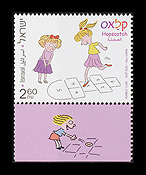|
"Yossi! Come home! It's getting late!" — that cry ended our courtyard games as children. Every afternoon neighborhood children of all ages would gather outside to play games, with no adults in sight — we ran, climbed, blocked and went over obstacles. Without realizing it, we developed motor and social skills, learned to stand up for ourselves and also to concede, how to cooperate and get along with others and to invent new rules for old games.
Hopscotch
Remember all the hopscotch boards that we drew in chalk along the sidewalks? How we'd toss a stone and hop on one foot from one square to the next. If we got tired and lost our footing or jumped imprecisely and stepped on a line or if our stone landed on a line — we were out and lost our turn, moving aside to watch our friends attempt to improve on our performance. The older kids played differently: first they tossed the stone onto a specific square, based on a predetermined order, jumped along to that square, picking up the stone as they jumped, and returned to the start. If we were joined by a child from a different neighborhood, he or she usually had to learn our rules, as every group of kids had their own version of hopscotch with its own set of rules.
Hide and Seek
First we'd choose one player to be "it" (the seeker) by doing "eeny meeny miney moe" or "rock paper scissors". Then that person would close his/her eyes, lean against a tree or pole, count out loud to 10 or higher and shout, "Ready or not, here I come!" This ended the time allotted to hide and began the game. Each player tried to sneak back to the "home base" without the seeker tagging him/her.
When players shouted "No hogging base" the seeker had to move away from the home base. If the seeker failed to find any of the hiders, he/she could shout "Come out, come out, wherever you are" and the hiders would call out from their hiding places. If the seeker spotted a hider, he/she would count to 3 loudly while knocking on the pole and say the hider's name, who would then exit his/her hiding place shamefully. But if a hider successfully reached the pole and knocked 1-2-3 on the pole while shouting out the seeker's name, it was a moment full of pride.
Tag
Screams, laughter and shouting "Help!" are all integral parts of the game of Tag, a running game whose object is to catch or tag players as they flee from the player who is "It". All types of Tag include running quickly while always staying aware of the seeker's location.
There are many versions of this game, each with its own rules. For example, a player who is caught may be required either to replace the seeker or to join him/her. In another version a player who is caught is "out" and must leave the game. Some rules of Tag allow those running from the seeker to take a break by shouting "time out" thus pausing from the game for a period of time. Reintegration into the game after a time out may also be done in various ways, as defined when the game begins. There are other versions of Tag such as "cops and robbers" or "boys vs. girls" in which there are numerous seekers, thus making it more difficult to escape. Some types of Tag feature a single seeker and a single player, who is chased while the other players stand motionless, such as "catch me".
Neighborhood games were the essence of our childhood and they played a significant role in shaping our characters, sense of determination and skills. The simplicity of these games and the ability to include children of all ages continue to allow adults to play with their children and to give them a taste of the experiences of our youth.
Dr. Mark Wertheim
Director
Wertheim Center for the
Development of Coordination
www.oco-gym.com



